-
Detailed travelogue on trek to the wow Tarsar and Marsar.
Whenever I am asked — “mountains or sea?” I don’t ever remember having
said anything but “mountains, of course”!
Is it because I was born in the middle of mountains
or that they have cast some spell on me. For I know that I belong to the
mountains.
Ever since I was a child, I had heard
stories from the elders in the family about different Nags (springs)
and Sars (lakes) that our beautiful Kashmir Valley has. Though many of these were easily accessible by
a vehicle, there were those alpine lakes which could be reached only on foot or
horseback. That’s because they sat very high up in the mountain passes and
valleys.
I decided to go on my first long-haul trek
to Kashmir. Being on the wrong side of the forties with no fitness regimen in
place, worried me. I spent days scanning the website of a popular trekking company
that listed more than a dozen treks across the Uttarakhand and Kashmir with a
“toughness” rating for each.
I selected a “moderate to tough” trek
between the various “easy” and “tough” ones, and of course, it had to be only
the Himalayas of Kashmir. This was in August of 2018. It was a solo trip for
me, in the sense, I was going to trek with a bunch of unknown trekkers from
across the country.
I chose Tarsar Marsar -
twin lakes, up in the Kolahoi mountains and e-met
the other 20+ trekkers I was to go with. This was June and the trek was
scheduled for August (6–13). We were asked to improve our fitness levels and
start a regular run, with the results to be uploaded on a mobile app. It was
serious stuff, I thought! Obviously, I had met the initial screening criteria
of having no serious ailments and my BMI being within the required limits. The
only thing to be established was that I could sustain the long periods of
walking/climbing in a high altitude environment.
The trekking company was very particular
about the pace at which each individual would walk because they have a tight
itinerary to follow. So, it had informed us upfront that anybody who is too
slow so as to slow the entire group down, would be sent back! This fear was my
biggest motivation.
Day 1: Srinagar
to Aru
The group was to meet in Srinagar (5200 ft.) on
August 6 afternoon so that we could set out for the base camp together. Aru, near Pahalgam,
was to be our base camp. Aru Valley is very picturesque - a hamlet of lush sloping
meadows dotted with flowers and pine trees.
It was a 3 hour drive from Srinagar to Aru.
There, we met with our group leader cum paramedic Yash, an experienced trekker and
pro on this route. He was assisted by another experienced trekker, Jaiveer.
Both belonged to Uttarakhand. We also met the rest of the team that accompanied
us - cooks, helpers who would carry our tents, sleeping gear and dry ration on
horses. We also met two local Kashmiri guides - Faizaan and Muzaffar, who knew
the mountains like the back of their hand. A pony was with us all the time, for
any kind of emergency, as that would be the only mode of transport to reach the
base location quickly.
Starting from Aru, the 5-day trek would
cover Lidderwat, Shekwas, Tarsar, Sundersar and Marsar.
I had shopped for everything at very
popular sports store – Decathlon. The trekking team had shared a checklist
beforehand - of clothing, medicines and accessories that we would need to carry with us. Two things, that I
realized the importance of, were the trekking pole and good
shoes.
After getting a detailed briefing from our
group leader, we set out. He handed over our medical cards in which the pulse
and oxygen levels would be recorded, twice every day. He had particularly
cautioned us on Acute Mountain Sickness that could set in with a
steep ascent in a short span of time. Ideally, one should not gain more than a
1000 feet in altitude daily. We took half-a-tab of Diamox, twice a
day, as a preventive measure.
We left our excess baggage at the base
camp. Carried only our rucksacks and a day backpack. It was going to get cold
as we gained height. So, we put on several layers of clothing, wore our
trekking shoes, carried a trekking pole and threw a waterproof poncho on top as
it was raining.
Day 2: Aru to
Lidderwat
The climb from Aru (7,958
ft.) to our first milestone, Lidderwat (9,131 ft.), took us
about 7 hrs for 10 km. It was not very steep yet challenging enough for a
newbie like me. The route was very scenic - fluffy clouds hanging so low that
you could almost touch them, cows grazing happily on the wet green slopes and
surrounded by heavenly alpine flora. Closest that one could have felt to
nature!
When we reached our campsite huffing and
puffing, we found our sleeping tents ready. Along with them, were the other
tents set up – a makeshift kitchen, a dining room and two toilets.
Each sleeping tent housed three people
with their individual mats and sleeping bags. The kitchen tent was huge as it
had to have space for gas stoves, big pots & pans and ration. The dining
tent was the biggest, where everybody’s rucksacks would be stored (we would
carry only the day backpack) and where everybody would gather in the evenings.
The toilets were dry ones. Basically, a small pit dug afresh at every location.
You just had to carry tissues with you!
Most people who I discuss treks with, ask
me more about the toilet, so in case you have any queries, I can answer those:)
Day 3: Lidderwat
to Shekwas
Next morning it had stopped raining. It
was a short climb that day, we reached our site Shekwas (11,039
ft.) by late afternoon. We did 5.5 km in about 5 hrs.
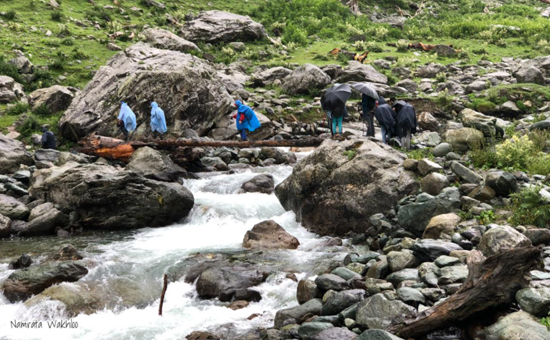 Crossing the Lidder at Shekwas.
Crossing the Lidder at Shekwas.
If you want true solitude, then mountains
are the answer. The high-altitude wilderness. Wilderness so beautiful. Everything is in perfect harmony — the tall,
purple headed mountains, the breeze carrying the heady fragrance of pines and
cedars, the wild flowers spouting from within the rocks, the calming sound of
the river flowing along with you…. for me it was complete
decluttering of my mind and truly comforting. God chose to leave humans out of
this habitat so you actually find none around.
The entire trek was along the river
Lidder, which would vanish in between and show up again, close to the Kolahoi mountains,
surrounded by endless slopes of thick forests and a blue sky.
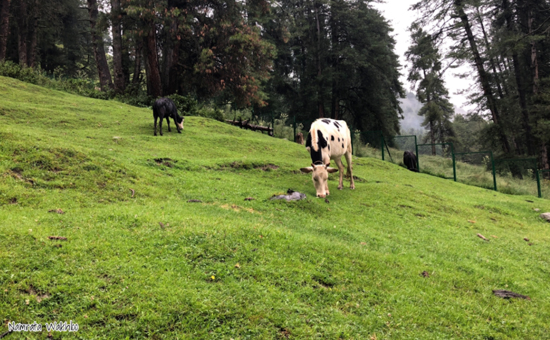 Grazing at Aru.
Grazing at Aru.
One does occasionally find Gujjars and
Bakerwals grazing their sheep or just moving livestock. They live in hamlets
which consist of a few dhokas (mud huts) with a little
vegetable patch outside their home. These nomads spend only the summer months
up there; they move down to Aru or Pahalgam before winter sets in. The
mountains get freezing cold with the mercury plummeting down to double digits
below zero. The passes become completely inaccessible then.
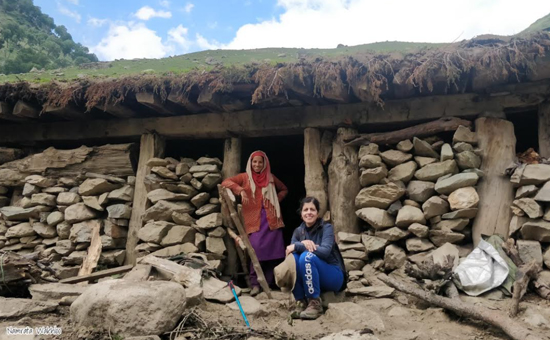 Dhoka (mud huts).
Dhoka (mud huts).
Whenever we would be lucky enough to find
a dhoka on our trail, we would request for some hot kehwa
(green tea) or noonchai (salt tea). The nomads introduced the
group to maeshkraer (local mozzarella-like cheese) which we
were taught to roll up and eat! Usually, we Kashmiris, fry it and season it
with salt and chilli powder before eating it, but here I learnt that you could
have it raw too (not sure if it’s advisable though).
Since we had spare time that day, Yash and
Jaiveer decided to take us to a small lake across the hill under which we had
camped. We were to go after lunch. Everyone was excited to see our first alpine
lake called Zadisar. So, we climbed uphill and then downhill on the other
side, crossed a stream and found a sparkling little emerald pool nestled within
the mountains. Since, these lakes are snow-fed, they are all blue-green in
colour.
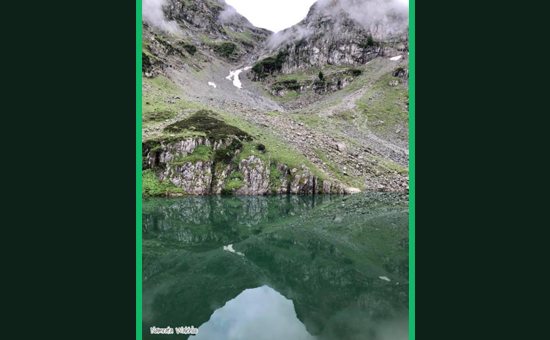 Zadisar Lake.
Zadisar Lake.
Day 4: Shekwas to Tarsar
All of us were upbeat that morning. It was
the trek to lake Tarsar (12,449 ft.), after all! The 5 km long
trail took us 5 hrs to complete. We camped close to the lake.
Our campsite would always be ready for us
because the support team would reach earlier (they had ponies) and we would
have piping hot tea and pakoras
waiting!
It is not easy to provide nourishing meals
at such remote locations. That’s why the time-table was set firm too and the
trekkers had to discipline themselves. That was non-negotiable. Or, you just
miss your grub.
The bunch of helpers would begin their day
early at 5 am. They would serve tea (usually kehwa) at 6 am
and give a “wake up” tap at each tent. Breakfast was served at 8 am. A well
balanced meal of milk, cereal/poha, eggs, bread would normally be there for
breakfast. All trekkers had been told to carry a tiffin box and a mug of his own
before starting from home. Each one ate from his own tiffin, washed it on his
own and got his lunch packed in it. Lunch time used to be the most exciting
time of the day.
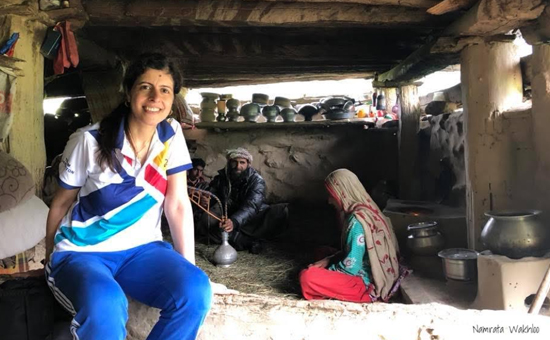 Inside a Gujjar home.
Inside a Gujjar home.
Having trekked for a few hours, we used to
be famished, with both – legs and lungs almost having given up, by the time
lunch would be announced. This was the set routine. The guides always had
excellent locations ear-marked beforehand where we could take a picnic break.
What better setting for lunch than this — a green meadow, with a stream flowing
by and some boulders to rest against!
On each day, we would reach the camping
location only by late afternoon or early evening. Tea and a snack would be
ready for us. We used to literally polish off the last bit in the bowls. Dinner
would be served at 8 pm in the Dining/Recreation Tent. After dinner, we would cozy-up
inside the tent, sing songs or listen to ghost stories (some real experiences
would be shared, mostly by the trek leaders). Many would wait until late in the
night and do star gazing. You could see the shimmering Milky Way on a clear
night.
The 16th-century Kashmiri ruler Yusuf Shah
Chak mentioned the twin lakes in his poetry to his beloved, Habba Khatoon:
“When I remember the two tresses of the comely beloved,
Tears begin to flow from my eyes like streams from Tarsar and Marsar.”
The Tarsar Lake is
surrounded by the peaks of the Kolahoi mountain. It is separated by a mountain
from another similar lake known as Marsar. Together, these two
lakes are referred to as the twin sisters. Tarsar drains into the River Lidder
at Lidderwat and Marsar drains out in the opposite direction of Tarsar.
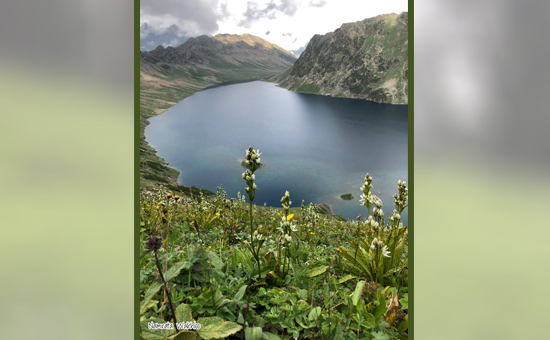 Tarsar Lake.
Tarsar Lake.
The highlight of this trek would always be
our adventurous climb from Tarsar up a very steep ridge to see Marsar from a
distance. Those 4 hrs of the uphill and downhill trek was the toughest in the
entire trip.
And, my personal best. It was not that we
had not done such steep inclines in the previous days, but the fact was that
this was not a regular trekking trail. A trail already in place in the
mountains makes it a lot easier for those who climb later, as it reduces the
effort of the trekker. These trails are usually made by the nomads or by some
nature enthusiasts like us. Here, there was none!
To reach the base of the ridge, we walked
around the circumference of Tarsar, most of it over huge boulders and then on a
gradually increasing incline. However, the trail suddenly vanished. We could
just see a rocky slope staring at us at a scary incline.
Once we started to climb straight up, we
had just wild grass to hold on to and the trekking pole to support. It was, in
short, the most arduous one hour of my trekking life! We were climbing at an
altitude of 13000 ft., the lungs would give up after every 60 seconds and there
was no choice but to pause and gain breath.
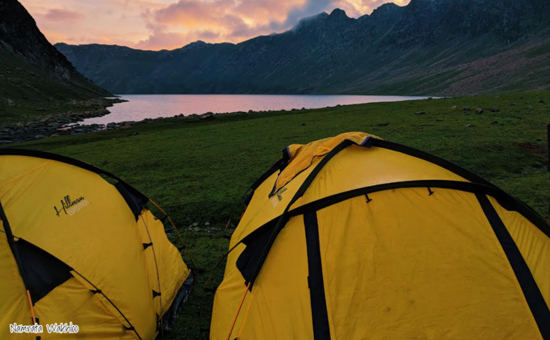 Camping at Tarsar.
Camping at Tarsar.
During the entire trek, we covered a total
of about 55 kms, which is supposed to be a big deal in a high-altitude terrain.
The day would consist of climbs uphill and downhill and uphill…from one
mountain to another….!
When the going would get tough on a very
steep climb, we would turn to the guide and ask “aur kitna hai lunch time
tak” and he would smile reassuringly and say “bas yeh jo pahadi hai,
isko paar karte hee” and we would get charged up not knowing that it
still meant a couple of hours or so! The local guides accompanying us were very
friendly and jovial. They were especially nice to me and would break frequently
into Kashmiri with me to the surprise of the rest of the group. They would
offer to carry my backpack or give me that extra helping of food as a warm
gesture which only a Kashmiri would understand. I remember how, one morning,
they had managed to get some “desi” milk and I got a mugful before everyone
else!
At times, while pushing yourself to go
that extra kilometre, you wonder whether you would make it or not. But when you
do so, at the end of the day, the feeling of accomplishment is hard to explain.
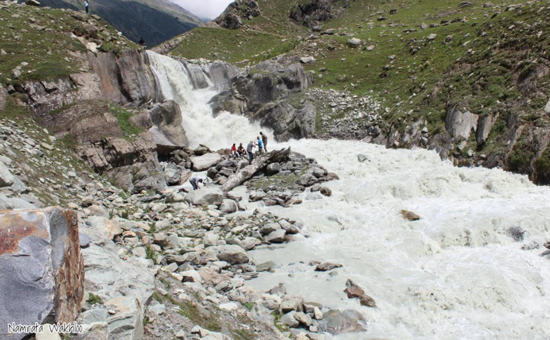 Satlanjan Waterfall
Satlanjan Waterfall
Day 5: Tarsar to
Lidderwat
On our return, since most of it was
downhill, we started at 8 am from Tarsar and touched Lidderwat by early
afternoon. After some refreshments, the guide suggested a 4–5 hrs trek (both
ways, included) to Satlanjan Waterfall.
The source of this waterfall is the Kolahoi glacier (about 6 km further from
there) and it empties into the River Lidder.
The trek was flat with only some mild slopes
in the ground, some rocks to be maneuvered and some brooks to be crossed over
logs of wood. In fact, crossing these streams over makeshift bridges made of
logs had become a norm by this time. The scariest crossing being the one when
we had to cross the gushing waters of Lidder between Lidderwat and Shekwas.
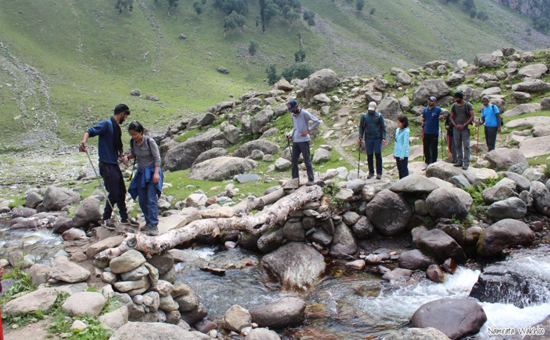 In the Lidder Valley.
In the Lidder Valley.
Although this was almost the last leg of
the trek, but for me this was the most beautiful part of this entire trip. I
simply loved the walk, with the mountains on one side and Lidder on the other,
surrounded by tall birch trees and other vegetation. All these days, it was the
water of Lidder that we all had been drinking — nothing has tasted purer.
The long walk had already made us hungry. We
were not carrying lunch that day. But where would one eat? In that part of the
world, not a soul was to be found, forget any shack or dhabha. And that’s when our local guide, Muzzafar, coaxed us to
walk just a few minutes more and promised that he would get us something to
eat. We wondered how he would manage to find food in that back-of-the-beyond
place. Little did we know that we were on his home turf.
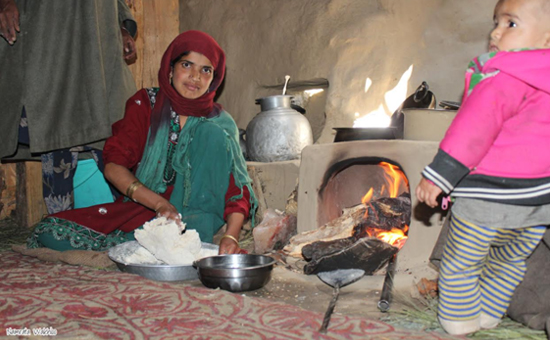 Muzzafar Home.
Muzzafar Home.
We spent close to an hour in his home. We,
obviously, took the family by surprise. The way all the womenfolk in the family
put a quick meal together for a bunch of 20 famished souls was nothing less
than heartwarming! The affection and thoughtfulness with which they served us
left a very sweet memory in my heart.
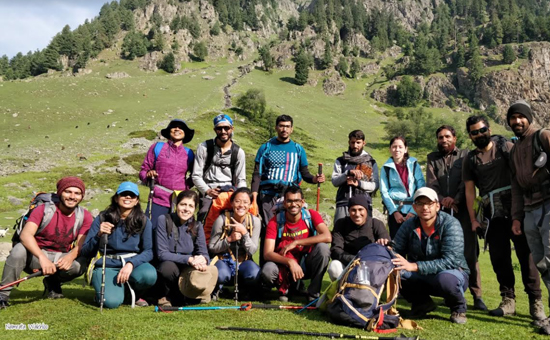 Trekking Group.
Trekking Group.
Day 6: Lidderwat
to Aru
The last day was an emotional one, as is
the case for any group when they disband. We had bonded, and bonded better than
most groups because of the challenges we had faced together. We had seen two
people turn back on day two itself because of AMS, another woman could not
climb after the first day, so we had to persuade her not to give up but use the
pony instead, then there was a case of low blood pressure and so on, but
everybody pushed each other to go on.
We had packed up by 7 am. We began the
downhill trek to Aru non-stop. It was fun to enjoy the same beautiful track,
which, while going up, we had struggled with, in the rains. By afternoon, we
were in Srinagar saying our good byes! We promised to meet again, one some
other day, on some other trek, god-willing.
Trekking teaches you resilience, patience,
resolve and above everything, adjusting to change, besides taking you to
exotic locations!
*We had to alter our
itinerary a bit due to unrest in Srinagar which delayed the start, so could not
go to Sundersar.
To
read all articles by author